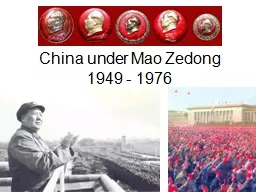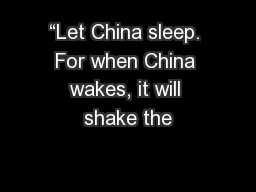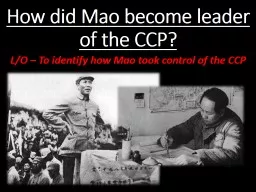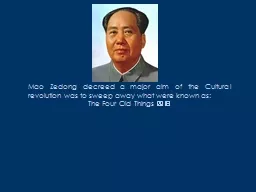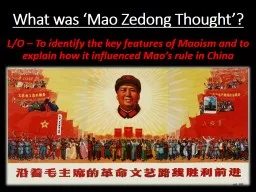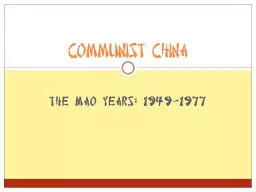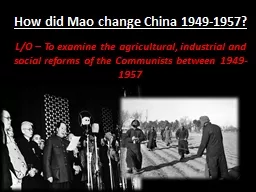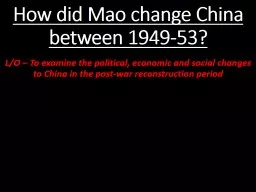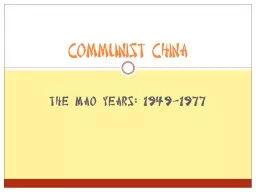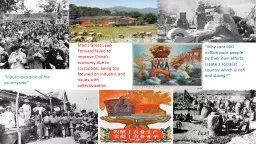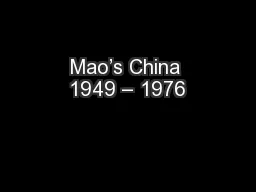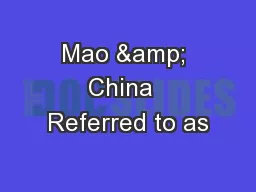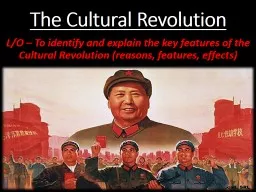PPT-China under Mao Zedong
Author : alida-meadow | Published Date : 2017-06-02
1949 1976 Outline GMDCCP Civil War 19461949 Recovery and Socialism 19491956 Rethinking the Soviet model 19561957 Great Leap Forward 19581961 Recovery amp growing
Presentation Embed Code
Download Presentation
Download Presentation The PPT/PDF document "China under Mao Zedong" is the property of its rightful owner. Permission is granted to download and print the materials on this website for personal, non-commercial use only, and to display it on your personal computer provided you do not modify the materials and that you retain all copyright notices contained in the materials. By downloading content from our website, you accept the terms of this agreement.
China under Mao Zedong: Transcript
1949 1976 Outline GMDCCP Civil War 19461949 Recovery and Socialism 19491956 Rethinking the Soviet model 19561957 Great Leap Forward 19581961 Recovery amp growing elite division 19625. Danyall Saeed, Elaine Ma, Nick Besley, and . Maddie. Alderfer (Group 1). Period 6. May 29, 2014. Mao Zedong- Danyall Saeed. Great Leap Forward & the Five-Year Plan- Elaine Ma. Bei . Dao- Nick Besley. L/O – To identify the key features of Maoism and to explain how it influenced Mao’s rule in China. Lesson 1a – . Mao Ideology. Essential Question. What was . Mao Zedong Thought?. Learning . Outcomes - Students will:. Confucianism - The philosophy has shaped the Chinese political system since the 6th century B.C.E. . It emphasized the importance of order and harmony, and encouraged Chinese citizens to submit to the emperor's power, and reinforced the emperors' responsibility to fulfill his duties conscientiously. . L/O – To identify how Mao took control of the CCP. Tasks. Make a timeline of Mao’s rise to power from 1919-1937. Include a brief description of each event (50 words max).. What were the most important events in Mao’s rise to power? Why? (try to identify at least 3 events). decreed a major . aim of the Cultural revolution was to sweep away what were known . as: . The Four . Old Things . 四. 旧. Mao Zedong . decreed a major . aim of the Cultural revolution was to sweep away what were known . L/O – To identify the key features of Maoism and to explain how it influenced Mao’s rule in China. Origins of Mao Zedong Thought. Mao Zedong Thought or . Maoism. was shaped by Mao’s upbringing and early life.. Communist China. The . Good Years: 1949-1958. China Packet III, Assignment 1. Assignment 1. New Expectations. Once the Nationalists were defeated, . Chairman Mao Zedong . and China’s Communists brought changes to every village. When dedicated Communist Party members arrived in a village to enact changes, he or she (usually) had the support of grateful peasants. . L/O – To examine the . agricultural, industrial and . social reforms of the Communists between 1949-1957. What problems did Mao have in 1949?. Try to think about the legacy of the Second World War and Civil War on China. L/O – To examine the political, economic and social changes to China in the post-war reconstruction period. “Now I have power, what problems does China face?”. 中国人民从此站起来了. !. Communist China. The . Good Years: 1949-1958. China Packet III, Assignment 1. Assignment 1. New Expectations. Once the Nationalists were defeated, . Chairman Mao Zedong . and China’s Communists brought changes to every village. When dedicated Communist Party members arrived in a village to enact changes, he or she (usually) had the support of grateful peasants. . “Industrialization of the countryside”. “Why cant 600 million poor people by their own efforts create a socialist country which is rich and strong?”. Thesis:. Mao’s Great Leap Forward failed to improve China’s economy due to corruption, being too focused on industry, and issues with collectivization.. Introductory Lesson . What does China mean to you? . What does this man mean to you? (if anything?) . Do you know any of these places? . B. C. D. A. E. F. Who was responsible for the most deaths…? . Chairman Mao. . Chinese communist revolutionary. guerrilla warfare strategist. author . political theorist. and leader of the Chinese Revolution. . He was the architect of the People's Republic of China (PRC) from its establishment in 1949, and held authoritarian control over the nation until his death in 1976. . Mao Resigns. Mao . resigned. as President of China in . 1959. . He remained as . Chairman. of the CCP. China was now controlled by three leading Communists:. President, . Liu . Shaoqi. Prime Minister, .
Download Document
Here is the link to download the presentation.
"China under Mao Zedong"The content belongs to its owner. You may download and print it for personal use, without modification, and keep all copyright notices. By downloading, you agree to these terms.
Related Documents

